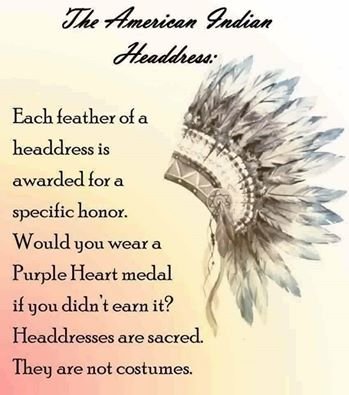Native Head Dress Argument:

Today on Facebook... I saw people in the comments arguing about it, or criticizing people for not knowing. I responded with this:
"Sadly, most people don't have a reason to know it's significance. For most "Americans", it's not something taught in schools. And unless someone tells them, or they feel the need to look it up themselves, they will spend the rest of their lives not knowing. It's always easier for people to just accept what they were taught in school as truth, and leave it at that. :(
With that said, we also need to remember that these people were fed ignorance, most did not choose it (They simply chose not to question it). It's our job, and those with the knowledge to teach, without criticism, those who are willing to learn.
I see too much scolding and too little teaching these days."
Now, with that said, I'd be a hypocrite if I didn't follow through. Below you will find some information on exactly what the headdress signifies. I urge you to also look deeper. Conduct your own research and learn. And once you do, spread that awareness to others. This goes for all things in life... the truth is always important, even when it's hard to swallow.
Native American Headdress:
Native American tribes consider the presentation of an eagle feather to be one of their highest marks of respect. Any honored person must have earned their feather through selfless acts of courage and honour, or been gifted them in gratitude for their work or service to their tribe. Traditional deeds that brought honour would include acts of valor in battle, but also political and diplomatic gains or acts that helped their community survive and prosper. The esteem attached to eagle feathers was so high that in many cases, such as a warrior (e.g. Dog Soldiers of the Cheyenne), only two or three honour feathers might be awarded in their whole lifetime. Historically, the warrior who was the first to touch an enemy in battle and escape unscathed received an eagle feather. When enough feathers were collected, they might be incorporated into a headdress or some other form of worn regalia. Headdresses were usually reserved exclusively for the tribe's chosen political and spiritual leaders.
That is one of the prizes for acquiring new lands .We keep them in Museums .